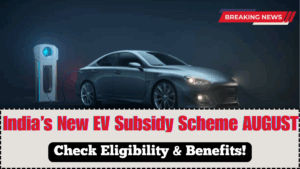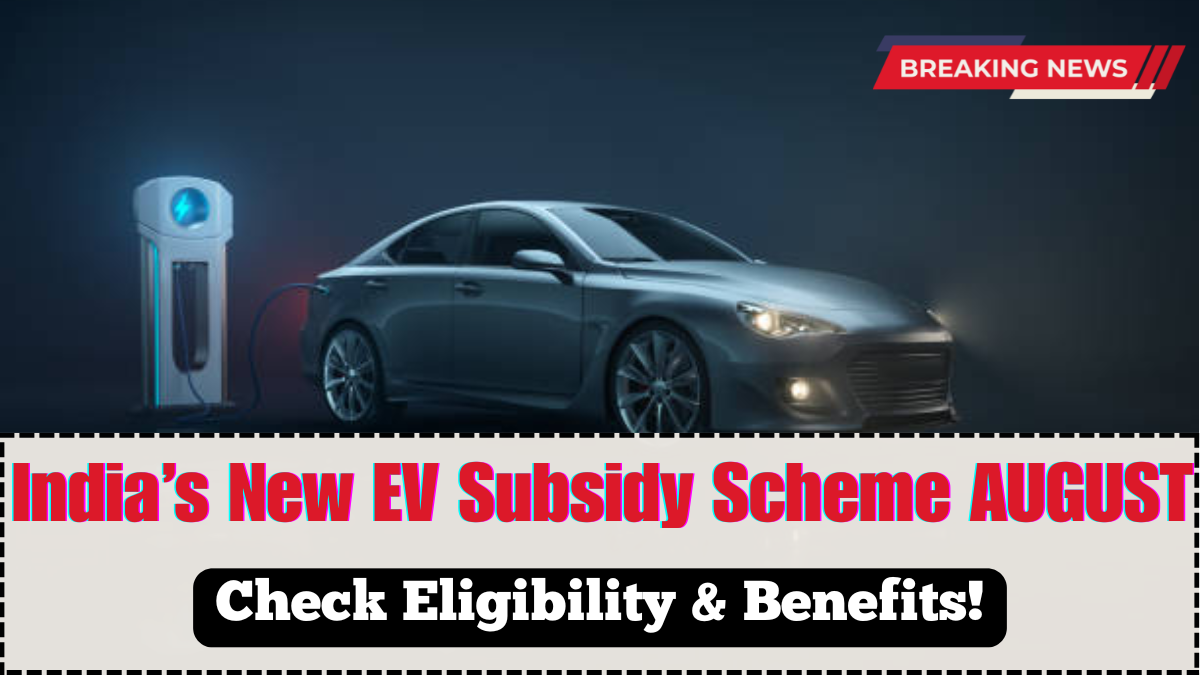The India’s New EV Subsidy Scheme August 2025 has officially been extended by the government to encourage wider adoption of electric vehicles. With rising fuel costs, environmental concerns, and the goal of reducing carbon emissions, this move supports sustainable transportation while providing financial relief to car buyers.
This extended electric vehicle scheme is especially beneficial for middle-class consumers looking to switch to cleaner technology. From increased subsidy amounts to simplified registration, the government has taken major steps to support buyers and promote cleaner energy on roads.

Key Features of the August 2025 EV Subsidy Scheme
The updated India’s New EV Subsidy Scheme August 2025 includes increased financial support and simplified eligibility norms. This move is aligned with India’s clean energy roadmap and helps promote electric cars across urban and semi-urban regions.
Important features include:
-
Direct subsidy of up to ₹1.5 lakh for electric four-wheelers
-
₹10,000 per kWh battery capacity incentive (capped at ₹1.5 lakh)
-
No road tax and registration fee on EVs in most states
-
State-wise additional incentives available
-
EV loans at reduced interest rates via government banks
These government benefits aim to make electric vehicles more affordable and accessible for everyday citizens.
Eligibility Criteria for Car Buyers
The government has set clear eligibility guidelines for individuals looking to benefit from India’s New EV Subsidy Scheme August 2025. The scheme is open to both first-time buyers and fleet owners, provided the vehicles meet specified criteria.
To qualify:
-
The vehicle must be manufactured and sold by an OEM approved under the FAME-II scheme
-
Only high-speed electric cars with advanced battery systems (lithium-ion or equivalent) are eligible
-
The buyer must be an Indian citizen with a valid ID and PAN
-
The vehicle must be registered before August 31, 2025
-
Only one EV subsidy per buyer is allowed under this scheme
This ensures a fair and transparent distribution of government benefits to deserving car buyers.
How to Claim the Subsidy
Under the India’s New EV Subsidy Scheme August 2025, claiming the subsidy is a streamlined process. Most eligible dealerships have integrated systems with government portals, ensuring a hassle-free purchase and claim process.
Steps to claim the subsidy:
-
Select an EV model approved under the scheme
-
Purchase from an authorized dealership with subsidy processing rights
-
Submit PAN card, Aadhaar, and registration details
-
The subsidy amount is deducted directly from the vehicle’s invoice
-
Dealer uploads buyer and vehicle details to the central database for final approval
This process is transparent and reduces post-sale reimbursement delays for car buyers.
State-Specific Incentives and Additional Support
In addition to the central subsidy, several Indian states are offering localized benefits under their EV policies. These add-ons make the electric vehicle scheme even more appealing.
Examples include:
-
Maharashtra and Delhi offer additional ₹1 lakh subsidy
-
Gujarat provides a 100% waiver on road tax
-
Tamil Nadu offers free charging facility for 1 year post-purchase
-
Karnataka provides a subsidy for commercial EV fleet owners
These layered government benefits help lower the overall cost of ownership and boost local economies.
FAQs
What is the maximum subsidy available under the scheme?
Buyers can get up to ₹1.5 lakh depending on battery capacity and vehicle model.
Can I claim the subsidy on used electric cars?
No, the subsidy is available only for brand-new electric vehicles registered for the first time.
Are two-wheelers and three-wheelers included?
This article focuses on electric cars. However, separate subsidy programs exist for two- and three-wheelers under FAME-II.
Do I need to apply separately for the subsidy?
No. The subsidy is applied automatically at the dealership during purchase if the vehicle is eligible.
What happens if I register the car after August 2025?
Vehicles registered after August 31, 2025, will not be eligible under this extended scheme.
Click here to know more.
